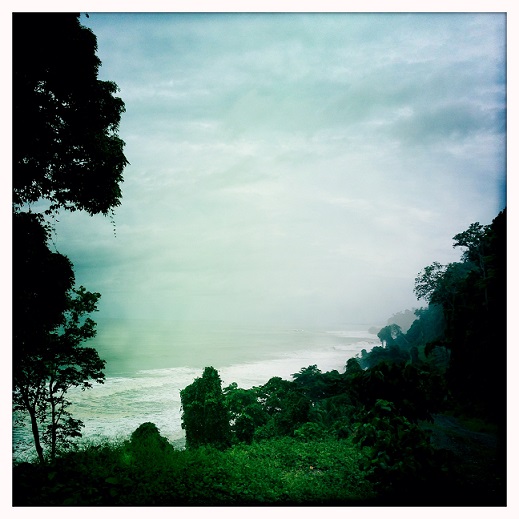Bobby Anderson
The road from Sorong to Tambrauw Bobby Anderson
In early April of 2013 it was reported that at least 95 indigenous Papuans had died of starvation in Kwoor sub-district, Tambrauw District, Papua Barat (West Papua). Another 553 were said to be seriously ill and at risk of imminent death. The deaths had begun in December of 2012 and most of the victims were concentrated in Tambrauw’s remote villages of Baddei (alt: Bakdei), Jokbi Joker (alt: Jokjoker) and Kasyefo.
Tambrauw lies on the northern coast of the Kepala Burung or Bird’s Head peninsula. This starvation report was particularly ironic in that Tambrauw is located next to some of the richest fisheries in the world. Although much of Tambrauw’s population is concentrated on, and makes their living from, the sea, the starvation-affected villages are all inland, with the closest a six-hour walk from Kampung Kwoor, and the furthest a three-day walk. This story resonated: it was indicative of the Indonesian government’s callousness toward the indigenous citizens of its easternmost and most under-developed periphery. And for many it was more evidence to support allegations that genocide is occurring in Tanah Papua.
The story grew more worrisome with news that two Papuan activists, Yohanis Mambrasar and his father, Hans, were arrested in the Tambrauw capital, Sausapor, for compiling a dossier of local deaths, apparently due to lack of medical care. The Asian Human Rights Commission reported that the two were interrogated for hours about separatist activities in the area and an urgent appeal was issued by AHRC on their behalf. Implicit in the news of this arrest were two things: that the starvation must be much more widespread than initially reported, and that the authorities were attempting a cover-up.
After a few weeks of attention to this starvation in select media outlets and independence listservs, the story faded from the news - yet another example of structural violence perpetuated against Papuans by the state, while brave activists trying to uncover such crimes disappear into police custody.
This incident is even more important because the alleged starvation didn’t actually happen.
Origins of the story
The story of starvation in Kwoor was first published in Suara Papua, a purported online news service provider. It was authored by Oktovianus Pogau and the source was attributed to Indonesia’s foremost coalition of ‘indigenous’ peoples, Aliansi Masyarakat Adat Nusantara (AMAN). The story was duly picked up and disseminated by activists including the Australia West Papua Association, the Free West Papua Campaign, West Papua Media, ETAN, and other groups, and soon it received coverage in Suara Pembaruan, Radio New Zealand International, Scoop, Jakarta Post, The Jakarta Globe, Kompas, Waspada and other Indonesian media.
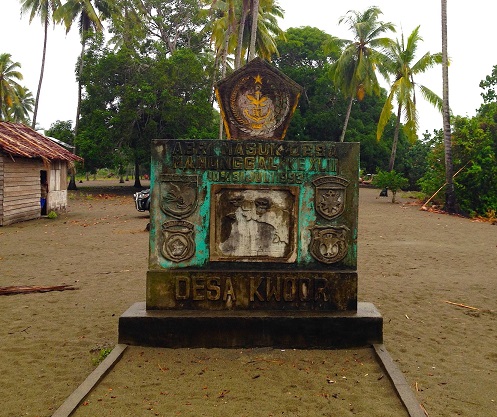 An old ‘ABRI Masuk Desa’ Memorial in Kwoor, circa July 1993 Bobby Anderson
An old ‘ABRI Masuk Desa’ Memorial in Kwoor, circa July 1993 Bobby Anderson
When this starvation story was first reported, it appeared to be quite plausible. Food security is an issue in Papua and there were significant emergencies, mostly in highland areas, from the mid-1990s up until around 2005 that necessitated outside responses. In the more remote highlands where I travel, I continue to see evidence of childhood malnutrition and stunted growth. What was so unusual about Tambrauw was that it is on the coast, and that the remote inland areas, while difficult to access, are walkable within a matter of days. How, then, could people starve to death there?
In April 2013 – on the same day that a friend with connections to foreign independence activists in New Zealand alerted me to the story – I contacted two Sorong-based volunteer health and education foundations with programs and staff in Tambrauw. I had worked with these foundations on service projects in 2012, and I knew them to be passionate advocates of Papuan rights. These are groups that are attempting to provide health services where the government does not.
Neither of these foundations or their staff was aware of any starvation in Kwoor, and this includes workers based in the villages named in the initial article in Suara Papua. In the meantime, the Indonesian government was issuing denials which were hardly taken seriously: when the government first responded to the story, it could only say that it was not aware of the cases and would follow them up. Such a statement is an implicit acknowledgement that there is no government representation in the areas concerned. Such a neglectful answer was taken as evidence that something terrible must have been occurring.
Over the next week, the staff of these two foundations searched for purported starvation deaths - not just in Jokbi Joker, Baddei and Kasyefo, but also in Syubi, and a day’s walk from there, in Kweserer and Kwekrisnos, the apparent epicentre of starvation’s victims, but they did not find a single starvation casualty. And they were diligent, not just cynically investigating the veracity of a claim. Rather, they were chasing down an alleged crisis in order to respond to it, as they would in any other humanitarian crisis.
One of those involved in the search was an expatriate doctor, a fluent Abun speaker, who has lived and worked for 14 years in Tambrauw’s Kwoor / Abun language areas. These workers found only a few fever-related deaths in Jokbi Joker, a six-hour walk from Kampung Kwoor and the coast. The workers were flummoxed, especially over how the number of 95 dead and 553 at –risk-of dying was calculated. Fever-related deaths in Jokbi Joker occur regularly. But was 95 the total number of deaths from fever over the last three or so years? They didn’t know. They still don’t.
I wanted to know how such a story could start and how it could simply end without closure or follow-up among both journalists and activists. If health workers rapidly concluded that the story was a fraud, why couldn’t the people who had disseminated the story in the first place?
A road trip to Tambrauw
In January 2014, I drove with a colleague from Sorong to Sausapor, the capital of Tambrauw, and then continued to Kwoor. The road into Tambrauw starts to fall apart just into the hills above Kota Sorong, up where the city’s garbage dump and surrounding recycler’s shacks are. But then one begins to encounter vast tracts of new roads and retaining walls from a special autonomy-funded construction boom. New bridges replace older ones made of earth and entire trees. It becomes painfully obvious, the more one drives into remote Sorong and then Tambrauw, that these roads have one express purpose: to aid in the felling of these virgin forests. Independent logging camps and shacks nestle in distinctive clusters alongside small sawmills. Stacks of planks are visible on the roadsides while other trees are floated downriver.
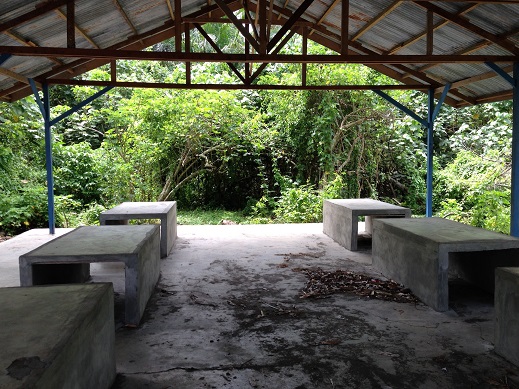 A market in Kwoor, built and forgotten Bobby Anderson
A market in Kwoor, built and forgotten Bobby Anderson
Leaving the hills for the coast, we encounter an atrocious road, hemmed in on one side by jungle and on the other by kudzu. Far below, the relentlessly pounding surf keeps us awake at night even a half mile from the water. Sausapor is reached five hours after leaving Sorong. It may be one of the dullest towns in Papua, built around an airstrip the Americans created at the end of WWII, with a few streets and shuttered shops. Two hours beyond Sausapor lies Kwoor.
Kampung Kwoor, the sub-district capital where services should be most available and most professional, hosts a local primary school with most of the windows smashed out. A secondary school, operated by a private foundation, still functions. From the writing on the chalkboard it seems the youth are learning about Indonesia’s role in ASEAN - a lesson intended possibly to teach the children that there are positive aspects to the state which are missing from their lives.
Evidence of previous failed development projects was in abundance: waterless outhouses; broken water tanks; a failed generator; a bare ‘traditional market’ used as a motorcycle parking lot; and so on. Kwoor’s bureaucratic centre is distinguished by derelict services, absentee civil servants, and empty government buildings: the insecurity that comes with too little state rather than too much.
To the east of Kwoor lies a series of villages that were once part of Kampung Kwoor. They became villages through pemekaran (the proliferation of administrative units). Unlike so many negative examples of pemekaran, the dissolution of Kampung Kwoor into multiple units makes complete sense - these units are up to a day’s walk from each other.
We attempted to go east, and we thought this would be easy, as my map indicated a bridge across the river immediately east of the kampung, and a road stretching along this coast. But the map was a fiction: the road ended where there was once a bridge but it was long gone. We crossed the river one-at-a-time in a skiff piloted by a 12 year old girl who paddled quickly because of her fear of crocodiles. Once on the other side, we walked for 45 minutes on a beach before using vines to scale a steep hill. We then reached the kudzu-entangled remains of a pioneer road which had been lost to arroyos (flash floods) in a matter of months. We walked on it for a half an hour before we realised it was once a road.
After another few hours we realised that the man leading us had no concept of space or time. He had only one answer for any query related to distance: ‘an hour and a half’. Further to the east of coastal Tambrauw lie the greatest leatherback turtle nesting areas on earth. Further inland lies a huge logging area, held under a 45-year concession, by a Jakarta-based company, PT Multi Wahana Wijaya.
The increasing friction of such topography makes travel difficult, but not unduly so. For us it was a question of time, not terrain. Were I to try to live off this land, I would fare badly, due to a serious lack of protein, but I could survive on fruit, root crops and water. The biggest threat would be from the irate owners of the root crops I would dig up, followed by mosquitoes. But for the locals who know it, Tambrauw’s jungle, rivers and ocean, all function as nature’s supermarkets.
How to starve to death
It is no cliché to say that Papua is a rich and fertile land. The same also applies to Tambrauw. The district is sparsely populated and its bureaucratic sustainability as a separate district is tenuous at best. Despite the advent of logging, Tambrauw is still heavily forested, and these forests abound with wild pig, tree kangaroo and a large rat that is considered a delicacy. This is to say nothing of cassava, taro, sago and sweet potato in the higher elevations, along with bananas, papayas, buah merah (a local red fruit shaped like a large carrot) and other fruits.
Starving to death is not an easy way to die. It is a long, drawn out process of macro-cellular breakdown, muscular atrophy, diminishing eyesight and organ failure. Those who die quickly in the right conditions die from a combination of starvation and dehydration, with the latter being the primary cause of death. For starvation with an unlimited access to water – which Tambrauw essentially has in abundance during the rainy November-March period, (when the 2012-13 starvation was alleged to occur), it would take over a month to die.
During famines, the elderly and the young are the first to succumb, followed by adults who will die according to their pre-starvation physical condition and reserves of muscle and fat. In theory, the 95 alleged to have died in Kwoor would have been already the weakest. They would have been abandoned en masse as the stronger ones relocated, with those they cared enough to assist. Even a few weeks into such a famine, the strongest would have reached the coast, dragging along or carrying their weaker members and children. Once on the coast the news of the exodus would have spread, through mobile phone cameras, sms, and the frantic movement of ailing humanity to Sausapor and Sorong. A story such as Suara Papua’s would have been the beginning of a deluge.
Such a condition of mass starvation, in such a land of plenty, would be impossible unless people were purposely denied food through the seizure of livestock and forest crops. However, such crops are notoriously hard to confiscate because, unlike rice, they are not stored between harvest and consumption. The only way this could happen is through detention in an area where the ability to forage was denied. A precedent, created by the Indonesian military, occurred in Lalerek Mutin, East Timor, in 1983, so the starvation allegation is more plausible to those viewing Papua through the prism of genocide favoured by many advocates of independence. We often associate genocide with images of physical structures like camps or barren fields surrounded by concertina wire. In Papua, of course, such images are absurd.
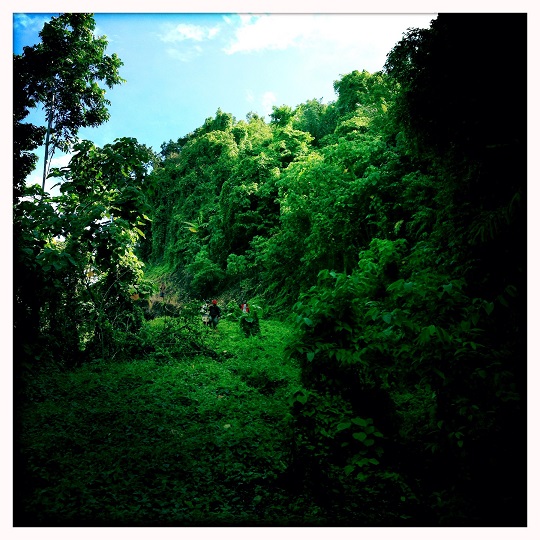 The ‘road’ stretching east from Kwoor Bobby Anderson
The ‘road’ stretching east from Kwoor Bobby Anderson
In my time in Tambrauw, I did not see a single soldier or police officer. The only evidence of the military in Kwoor is a mossy old concrete monument from the nationwide Suharto-era ABRI Masuk Desa(the military enters the village) campaign, circa 1993, where soldiers from the Cenderawasih Military Command conducted a ‘winning hearts and minds’ exercise by constructing new buildings and providing health services. Instead of the military, in Tambrauw I saw what I usually see in pemekaran districts: failure and absence. Papuans in Kwoor go about their lives as they always have, on foot or by boat and paddle, with only the slightest airbrushing of the state upon them, mostly visible in shuttered buildings, crumbling roads, useless infrastructure and stacks of planed wood destined for the outside world.
The conflicting roots of the story
The indigenous head of Baddei village – one of the villages named in the Suara Papua story – is still irritated by the starvation allegations, as are numerous ordinary Papuans I spoke to in Kwoor and Sausapor. But the head of Baddei has no idea that the story was picked up overseas or was used as anecdotal evidence of the Indonesian government’s crimes against its people. Instead, he and others believe that the allegation was created in order to discredit the district leader of Tambrauw, Gabriel Asem, and the local Golkar structure.
This was part of a local political struggle, they think, started by persons unknown. One person made the unsubstantiated claim that perhaps the story was created by one of the men who was arrested in Sausapor, allegedly for compiling dossiers on the deaths. It was speculated that Hans, the older of the two arrested men, may have acted out of positive intentions: he may have tried to bring pressure on the district government to provide urgently needed services in the remote areas named in the story. Just as in the Papuan highlands, sick people or even children who want to go to school – have to walk out of these areas and seek services in places where the roads actually reach.
The community health centre in Sausapor maintains a helicopter for emergencies in these remote areas but even this is ineffective: there is no SSB radio or mobile phone coverage in the areas where the alleged starvations occurred, and so news of a sick person in those places must travel via word of mouth, first to Kampung Kwoor and then to Sausapor. In any acute emergency, a person either would have recovered or died in the time it took for the news of their illness to reach the helicopter.
Upon my return to Jayapura, I was surprised to hear that the two Sorong-based foundations were not the only organisations which had tried to respond to that fabricated crisis. A health worker from one of the UN ‘sister agencies’ told me that his agency’s Manokwari-based medical staff had also been mobilised in April 2013 to verify the starvation reports and had travelled to the remote villages mentioned in the Suara Papua story.
A small team headed to Sausapor and used the district government helicopter to visit each of the villages where the starvation was alleged to have occurred. This team went so far as to count graves and visit family members of the recently deceased. While this team found a complete lack of services, they also found absolutely no evidence of starvation deaths. That agency wrote an internal report which was disseminated to the provincial and national governments, but no further.
Lessons to be learned
The story of Tambrauw’s (non) starvation is relevant for a few key reasons. It illustrates how uncritically people - Indonesians as well as foreigners - think about Indonesia, and about Papua. This story was accepted without reservation by numerous journalists and human rights activists the author is acquainted with, even though Oktovianus Pogau, the author of the initial story in Suara Papua, is well known for his sympathies with Papuan activist groups.
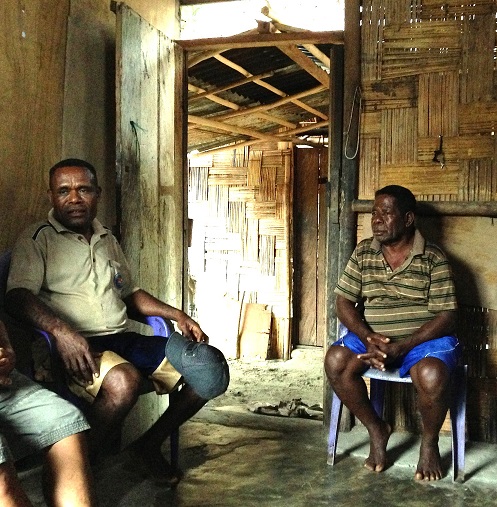 Two village heads discussing the starvation story, Kwoor Bobby Anderson
Two village heads discussing the starvation story, Kwoor Bobby Anderson
For many Papuans – motivated by the Memoria Passionis which they undeniably bear – there is no malice which the government, national or local, is incapable of. Papuan students in Yogyakarta demonstrated against this reported starvation. They were aghast and frankly, they had a right to be. The lack of accountability between the government and the citizens of its easternmost province over the nature of Papua’s incorporation into the Indonesian state, and the suffering of all the victims of that incorporation, give them every reason to be suspicious. That alienation leaves a space for such stories to take root.
Whilst Papuans might suspect malice, for most other Indonesians, the story was one of government dysfunction. For most Indonesians, there is no act of incompetence that the government is incapable of – especially when it comes to new local governments and the absentee bupatis (regional rulers) who behave like little princes. Friends in Yogyakarta, Jakarta and Makassar believed the starvation reports because they believe local government in Indonesia is rotten to the core.
But observers of Indonesian affairs, those who care about Papua and Papuans and the Indonesians themselves, have a responsibility to be suspicious and critical. This story was not true. Whatever goal this fiction had – either to support allegations of genocide and therefore an independent Papua, or to discredit a local leader – it weakened that goal. Nor did the allegation improve health services. Moreover the Indonesian government does itself no favours by not refuting what it knows to be untrue. That UN sister agency’s report apparently made it as far as the vice president’s office. Why no further?
Such sloppy and unverified reportage is often justified, post-exposure, as a device that serves to capture other previously unreported incidents. Papua has many such stories of neglect, and of starvation, with the last verifiable cases dating from 2006. The author has seen such malnutrition in the highlands in 2011 and 2012. But propagating fiction is not acceptable.
So much of Papua remains remote. Outside of the towns, there is a lack of health and education services, communication networks, good phone reception and passable roads. Stories emerge from these distant corners – of clan fights, of food emergencies, of sicknesses. The lack of development that prevents these stories coming out quickly and accurately is the responsibility of both national and local governments. And for that they deserve censure. But stories need not be invented in order to further excoriate government. In Papua, there’s enough truth to choose from without resorting to fiction.
Bobby Anderson (rubashov@yahoo.com) works on health, education, and governance projects in Eastern Indonesia, and travels frequently in Papua and West Papua. This and other articles on Indonesia can be found at http://independent.academia.edu/BobbyAnderson/.
